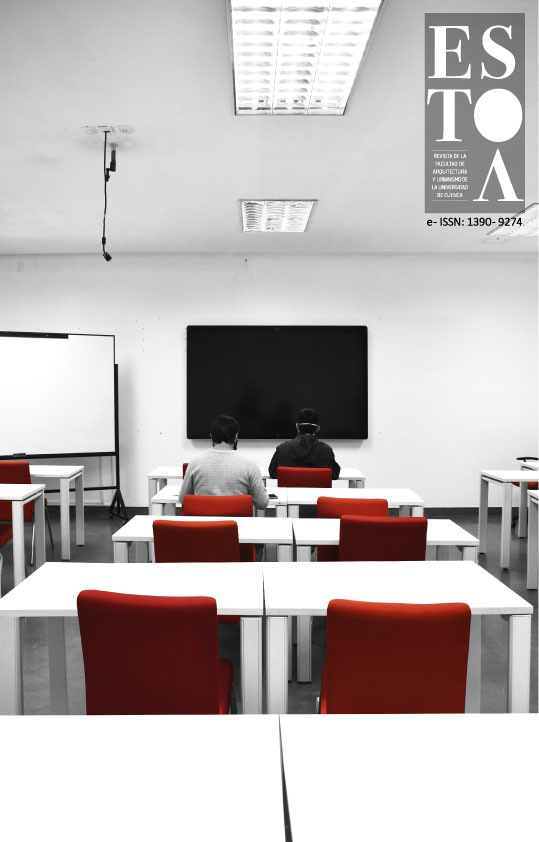Landscape and urban imaginaries: dynamics in the construction of identity and sense of place in Sincelejo, Colombia
DOI:
https://doi.org/10.18537/est.v009.n018.a03Keywords:
Imaginary, landscape architecture, cultural heritage, city center, , public spaceAbstract
Relations between urban imaginary and landscape are analyzed in a Colombian Caribbean city, Sincelejo, based on the integration of the results of two investigations on the same object of study, the historic center. One works the representations on elements of the public space from a phenomenological approach, the other, from a quantitative approach with the objective of analyzing the environmental and landscape conditions of the historic center, focuses on the inventory of urban trees and the analysis of environmental services it offers to the city. Among the findings, the interdependence relationship between landscape and inhabitant stands out, as well as the formation and consolidation of territorial identities in relation to the landscape. The landscape works as a catalyst for the satisfaction of the desires of multiple individuals, in this process man and landscape merge, giving meaning to the place, which turns these dynamics into a heritage to preserve and value in the city.
Downloads
References
Appleton, J. (1996). The landscape experience. Londres, Reino Unido: John Wiley and sons.
Benedict, M. A. y McMahon, E. T. (2012). Green infrastructure: linking landscapes and communities. Washington DC, USA: Islandpress.
Borie, M., Pelling, M., Ziervogel, G. y Hyams, K. (2019). Mapping narratives of urban resilience in the global south. Global Environmental Change, 54, 203–213. doi: 10.1016/j.gloenvcha.2019.01.001
Castells, M. (2012). La cuestión urbana. México DF, México: Siglo XXI editores.
Cidell, J. (2017). Sustainable imaginaries and the green roof on Chicago’s City Hall. Geoforum, 86, 169–176. doi: 10.1016/j.geoforum.2017.09.016
De Certeau, M. (1996). La invención de lo cotidiano I. Artes de hacer. México DF, México: Universidad Iberoamericana.
Gallardo Frías, L. (2012). De lo con-céntrico a lo des-centrado. Reflexiones sobre el lugar y el no-lugar en la arquitectura. Revista de Urbanismo (26), 106 – 120. doi:10.5354/0717-5051.2012.20926
Gallardo Frías, L. (2013). Lugar y arquitectura. Reflexión de la esencia de la arquitectura a través de la noción de lugar. Arquitetura Revista, 9 (2) 161-169. doi:10.4013/arq.2013.92.09
García-Canclini, N. (1997). Imaginarios urbanos. Buenos Aires, Argentina: Editorial Universitaria de Buenos Aires.
García Moreno, B. (2007). Ciudad, universidad y universitarios. Bogotá, el vecindario de la calle 45. Bogotá, Colombia: Editorial Pontificia Universidad Javeriana.
García Moreno, B. (2019). La ciudad de los habitantes y sus deseos. Procesos Urbanos, 6(6), 5-12. doi:10.21892/2422085X.451
Gorelik, A. (2002). Imaginarios urbanos e imaginación urbana: Para un recorrido por los lugares comunes de los estudios culturales urbanos. EURE, 28 (83), 125-136.
Gross, P., Buchanan, N. y Sané, S. (2019). Blue skies in the making: Air quality action plans and urban imaginaries in London, Hong Kong, and San Francisco. Energy Research & Social Science 48, 85–95. doi: 10.1016/j.erss.2018.09.019
Jacobs, J. (2013). Muerte y vida de las grandes ciudades. Madrid, España: Capitán Swing Libros.
Lindón, A. (2007). La ciudad y la vida urbana a través de los imaginarios urbanos. EURE, XXXIII, (99), 7 – 16.
Maderuelo, J. (2005) El paisaje: génesis de un concepto. Madrid, España: Abada.
Martín- Barbero, J. (2002). Jóvenes: comunicación e identidad. Pensar Iberoamérica. Revista de cultura (0). Recuperado de: https://www.oei.es/historico/pensariberoamerica/ric00a03.htm
Nogué, J. (2010). El retorno al paisaje. Enrahonar. Quaderns de filosofía. (45), 123-136.
Pérez-Igualada, J. y Vicente-Almazán, G. (2020). Espacio, tiempo y paisaje. La representación de procesos y experiencias visuales en el análisis, el proyecto y la planificación de los espacios abiertos. Estoa. Revista de la Facultad de Arquitectura y Urbanismo de la Universidad de Cuenca, 9(17), 31-39. doi:10.18537/est.v009.n017.a03
Pérgolis, J. C. (1998). Bogotá fragmentada. Cultura y espacio urbano a fines del siglo XX. Bogotá, Colombia: Tercer Mundo Editores.
Pérgolis, J. C. y Rodríguez Ibarra, C. I. (2013). El espíritu del tiempo en las ciudades y en sus libros. Revista de Arquitectura, 15 (1), 33-43. doi: 10.14718/REVARQ.2013.15.1.4
Pérgolis, J. C. y Rodríguez Ibarra, C. I. (2014). El método en la investigación: imaginarios y representaciones de la forma urbana en la vida cotidiana. Procesos Urbanos, 1(1), 17-24. doi:10.21892/2422085X.14
Pérgolis, J. C. y Valenzuela, J. (2008). El método en dos investigaciones urbanas: Estación Plaza de Bolívar e Imaginarios y representaciones en el transporte público de pasajeros. Revista de Arquitectura, (10), 15-25.
Pérgolis-Valsecchi, J. C. (2020). Investigación en Historia: Ciudad, Memoria y Arquitectura. Procesos Urbanos, 7(1), 1-13. doi:10.21892/2422085X.484
Pérgolis Valsecchi, J.C. y Quijano Gómez, E. (2019). Memoria, acontecimiento, objeto y lugar. Procesos Urbanos, 6(6), 13-21. doi:10.21892/2422085X.453
P.O T. (2015). Plan de ordenamiento Territorial de Sincelejo. Adoptado mediante decreto N° 438 del 21 de agosto de 2015. Sincelejo, Colombia: Alcaldía Municipal de Sincelejo.
Rojo, F. y Enríquez, G. (2010). Imaginarios sociales urbanos vinculados a barrios cerrados en el Gran Concepción, Chile. Sociedad Hoy, (18), 65-83.
Salazar, J. H. (2010). Uso y apropiación de los espacios públicos. Medellín, Colombia: Universidad Nacional de Colombia.
Silva, A. (2006). Imaginarios urbanos. Bogotá, Colombia: Arango Editores.
UNESCO (1972). Convention Concerning the Protection of the World Cultural and Natural Heritage. Paris, France: UNESCO. Recuperado de: http://whc.unesco.org/archive/convention-es.pdf
UNESCO (1977). 1st session of the World Heritage Committee. Paris, France: UNESCO. Recuperado de: http://whc.unesco.org/en/sessions/01COM/
UNESCO (2003). 27th session of the World Heritage Committee. Paris, France: UNESCO. Recuperado de: http://whc.unesco.org/en/sessions/27COM
UNESCO (2005). 29th session of the World Heritage Committee. Durban, South Africa: UNESCO. Recuperado de: http://whc.unesco.org/en/sessions/29COM
Published
How to Cite
Issue
Section
License
The Journal declines any responsibility for possible conflicts derived from the authorship of the works that are published in it.
The University of Cuenca in Ecuador conserves the patrimonial rights (copyright) of the published works and will favor the reuse of the same ones, these can be: copy, use, diffuse, transmit and expose publicly.
Unless otherwise indicated, all contents of the electronic edition are distributed under a Creative Commons Attribution-NonCommercial-ShareAlike 4.0 International License.




